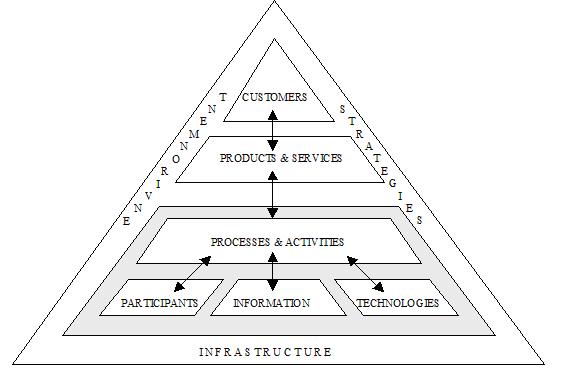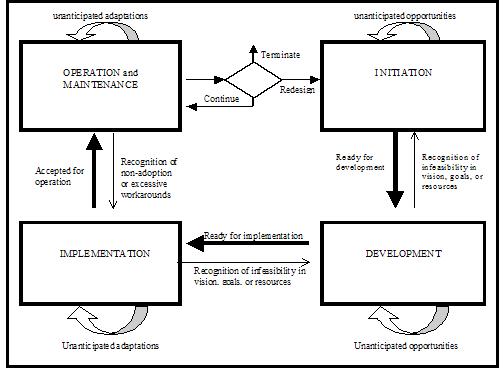Work systems theory
Work system theory
Acronym
N/A
Alternate name(s)
Work system approach, Work system method
Main dependent construct(s)/factor(s)
Performance of the work system as a whole; performance of the various elements
Main independent construct(s)/factor(s)
Nine elements of a work system: Customers, Products and services, Processes and activities, Participants, Information, Technology, Infrastructure, Environment, Strategy
Concise description of theory
A work system is a system in which human participants and/or machines perform work using information, technology, and other resources to produce products and services for internal or external customers. Information systems, projects, and supply chains are all special cases of work systems.
- An information system is a work system in which all of processes and activities are devoted to processing information.
- A project is a work system designed to produce a product and then go out of existence.
- A supply chain is an interorganizational work system devoted to procuring materials and other inputs required to produce a firm’s products.
- The use of an ecommerce web site can be viewed as a work system in which a buyer uses a seller’s web site to obtain product information and perform purchase transactions.
The relationship between work systems in general and the special cases implies that the same basic concepts apply to all of the special cases, which also have their own specialized vocabulary. In turn, this implies that much of the body of knowledge for the current information systems discipline can be organized around a work system core, rather than around special cases, such as DSS or CRM.
A static view of a work system is represented by the work system framework. A dynamic view of how a work system changes over time is represented by the work system life cycle model (WSLC).
The work system framework (diagram below) was originally developed to help business professionals recognize and understand IT-reliant systems in organizations. It identifies nine elements that are part of even a rudimentary understanding of a work system. Four of these elements (processes and activities, participants, information, and technologies) constitute the work system. The other five elements fill out a basic understanding of the situation. For example, no analysis of a work system is complete without some understanding of the customer’s view of whatever the work system produces.
The work system life cycle model (WSLC) represents a dynamic view of how work systems change over time. The WSLC is an iterative model based on the assumption that a work system evolves through a combination of planned and unplanned changes. The planned changes occur through formal projects with initiation, development, and implementation phases. Unplanned changes are ongoing adaptations and experimentation that change aspects of the work system without performing formal projects. The WSLC is fundamentally different from the system development life cycle (SDLC), which is basically a project model rather than a system life cycle. (Even iterative development models are basically about iterations within a project.) The system in the SDLC is a basically a technical artifact that is being programmed. In contrast, the system in the WSLC is a work system that evolves over time through multiple iterations. This evolution occurs through a combination of defined projects and incremental changes resulting from small adaptations and experimentation. The WSLC treats unplanned changes as part of a work system’s natural evolution.
Diagram/schematic of theory
The Work System Framework. (Adapted and slightly updated from Alter, 2006)
The Work System Life Cycle Model (Alter, 2006)
Originating author(s)
Steven Alter
Seminal articles
Bostrom and Heinen (1977a, 1977b) used the term “work system” extensively in two articles in the first edition of MIS Quarterly. Alter (1999; 2003; 2006) defined the term work system carefully and showed how it could be a central concept for understanding and analyzing IT-reliant systems in organizations.
Bostrom, R. P., & Heinen, J. S., (1977). MIS problems and failures: A socio-technical perspective, MIS Quarterly, Vol. 1, No. 3, pp. 17-32.
Bostrom, R. P. and J. S. Heinen, (1977) “MIS Problems and Failures: A Socio-Technical Perspective. PART II: The Application of Socio-Technical Theory.” MIS Quarterly, 1(4), December, pp. 11-28.
Alter, S. (1999) “A General, Yet Useful Theory of Information Systems,” Communications of the Association for Information Systems, 1(13), March. http://cais.aisnet.org/articles/default.asp?vol=1&art=13
Alter, S. (2002) “The Work System Method for Understanding Information Systems and Information Systems Research,” Communications of the Association for Information Systems 9(9), Sept., pp. 90-104, http://cais.aisnet.org/articles/default.asp?vol=9&art=6
Alter, S. (2003) “18 Reasons Why IT-Reliant Work Systems Should Replace ‘The IT Artifact’ as the Core Subject Matter of the IS Field,” Communications of the Association for Information Systems, 12(23), Oct., pp. 365-394, http://cais.aisnet.org/articles/default.asp?vol=12&art=23
Alter, S. (2005) “Architecture of Sysperanto - A Model-Based Ontology of the IS Field,” Communications of the Association for Information Systems, 15(1), Jan. 2005, pp. 1-40. http://cais.aisnet.org/articles/default.asp?vol=15&art=1
Alter, S. (2006) The Work System Method: Connecting People, Processes, and IT for Business Results, Larkspur, CA: Work System Press.
Originating area
Information systems
Level of analysis
The work system. Organizations consist of multiple work systems.
IS articles that use the theory
(in chronological order)
Sumner, M. and T. Ryan (1994). “The Impact of CASE: Can it achieve critical success factors?” Journal of Systems Management, 45(6), p. 16, 6 pages.
Ramiller, N. (2002) “Animating the Concept of Business Process in the Core Course in Information Systems,” Journal of Informatics Education and Research, 3(2), pp. 53-71. viewed at http://iaim.aisnet.org/jier/V3N2/
Sherer, S. A. and S. Alter (2004) “Information System Risks and Risk Factors: Are They Mostly about Information Systems?” Communications of the Association for Information Systems, 14(2), July, pp. 29-64. http://cais.isworld.org/articles/14-2/default.asp?View=Journal&x=32&y=8
Petrie, D.E. (2004) Understanding the Impact of Technological Discontinuities on Information Systems Management: The Case of Business-to-Business Electronic Commerce, Ph.D. Thesis, Claremont Graduate University.
Alter, S. (2004) “A Work System View of DSS in its Fourth Decade,” Decision Support Systems, 38(3), December, pp. 319-327.
Siau, K., H. Sheng, and F. F.-H. Nah (2004) “The Value of Mobile Commerce to Customers,” Proceedings of the Third Annual Workshop on HCI Research in MIS, Washington, DC, December, pp. 65-68.
Alter, S. and G. Browne (2005) “A Broad View of Systems Analysis and Design,” Communications of the Association for Information Systems, 16(50), December, pp. 981-999. http://cais.aisnet.org/articles/16-50/default.asp?View=Journal&x=26&y=13
Proper, H.A. (Erik) (2005) Work Systems Modeling Library.
Alter, S. (2006) “Work Systems and IT Artifacts: Does the Definition Matter?” Communications of the Association for Information Systems, 17(14), February, pp. 299-313. http://cais.aisnet.org/articles/17-14/default.asp?View=Journal&x=45&y=11
Cuellar, M.J., E. R. McLean, and R.D. Johnson (2006) “The Measurement of Information Systems use: Preliminary Considerations,” Proceedings of the 2006 ACM SIGMIS CPR conference on computer personnel research, April, pp. 164-168.
Petkov, D. and O. Petkova (2006) “The Work System Model as a Tool for Understanding the Problem in an Introductory IS Project,” Proceedings of the 23rd Information Systems Education Conference (ISECON 2006), Dallas, TX, November.
Alter, S. (2007) “Service Responsibility Tables: A New Tool for Analyzing and Designing Systems,” Proceedings of the Americas Conference on Information Systems (AMCIS 2007), Keystone, CO, Aug. 9–12.
Alter, S. (2008) “Service System Fundamentals: Work System, Value Chain, and Life Cycle,” to be published in IBM Systems Journal.
Petersson, J. (2008) “Work system principles: towards a justified design theory on the grounds of socio-instrumental pragmatism,” in Proceedings of the 3rd International Conference on the Pragmatic Web (PRAGWEB 2008), 69-76. http://portal.acm.org/citation.cfm?id=1479190.1479200&coll=ACM&dl=ACM&CFID=22048689&CFTOKEN=63832475
Links from this theory to other theories
Work system theory is related to General systems theory, but focuses specifically on systems within or across organizations.
Work system theory has some resemblance to Soft systems theory, but tries to be more prescriptive about what to consider.
External links
http://en.wikipedia.org/wiki/Work_system , A Wikipedia article about work systems.
Original Contributor(s)
Steven Alter
Please feel free to make modifications to this site. In order to do so, you must register.
Return to Theories Used in IS Research

